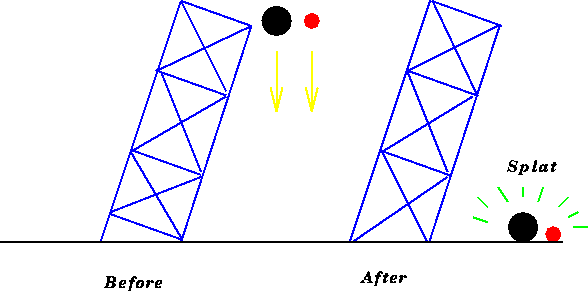So far we have been rather vague about what we mean by the mass of a body. Even in Newtonian theory we can ascribe three masses to any body which describe quite different properties:
Passive gravitational mass ![]() measures a body's response to
being placed in a gravitational field. Let the gravitational potential
at some point be
measures a body's response to
being placed in a gravitational field. Let the gravitational potential
at some point be ![]() , then if
, then if ![]() is placed at this point, it
will experience a force on it given by
is placed at this point, it
will experience a force on it given by
![]()
On the other hand active gravitational mass
![]() measures the strength of the gravitational field produced by the body itself. If
measures the strength of the gravitational field produced by the body itself. If ![]() is placed at the origin, then the gravitational potential at
any point a distance r from the origin is given by
is placed at the origin, then the gravitational potential at
any point a distance r from the origin is given by
![]()
We will now see how these three masses are related in the Newtonian framework.
Galileo discovered in his famous Pisa experiments [ see Figure 5.3 ] that when two bodies are dropped from the same height, they reach the ground together irrespective of their internal composition.

Figure 5.3: The Galileo Piza experiment.
Let's assume that two particles of inertial mass ![]() and
and
![]() and passive gravitational mass
and passive gravitational mass ![]() and
and
![]() are dropped from the same height in a gravitational
field. We have:
are dropped from the same height in a gravitational
field. We have:

The observational result is ![]() from which we get on
dividing
from which we get on
dividing
![]()
Repeating this experiment with other bodies, we see that this ratio
is equal to a universal constant ![]() say. By a suitable choice
of units we can take
say. By a suitable choice
of units we can take ![]() , from which we obtain the result:
, from which we obtain the result:
In order to relate passive gravitational mass to active gravitational mass, we make use of the observation that nothing can be shielded from a gravitational field. Consider two isolated bodies situated at points Q and R moving under their mutual gravitational attraction. The gravitational potential due to each body is
![]()
The force which each body experiences is
![]()
If we taken the origin to be Q then the gradient operators are
![]()
so that
![]()
But by Newton's third law ![]() , and so we conclude that
, and so we conclude that
![]()
and using the same argument as before, we see that
![]()
This may see obvious to you, but it has very deep significance and Einstein used it as the central pillar for his equivalence principle .